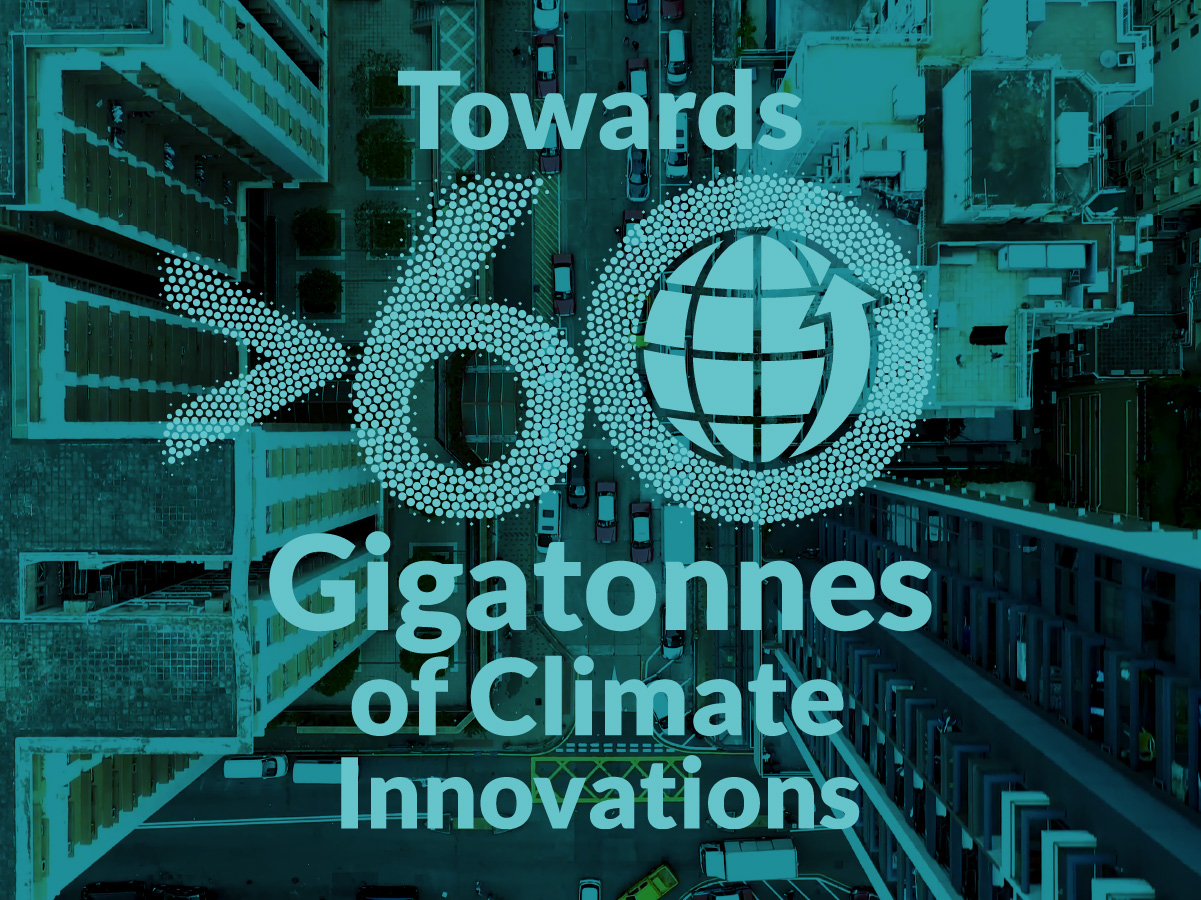Nominated innovations
1000 innovative clean energy solutions and > 150 framework enablers with the potential to deliver more than twelve gigatonnes of avoided emissions by 2030
These assessments are based on a basic avoided emission assessment. The overall concept of avoided emissions is that a solution (product or service) enables the same function to be performed with significantly less GHG emissions. The method of measuring avoided emissions, is to compare a baseline scenario without the enabling solution, with a scenario using the enabling solution; whereby the baseline represents the ‘business as usual’ (BAU) scenario.
These assessments are based on the framework document: The Avoided Emissions Framework (AEF) from September 2020

Solar4Schools
Solar4Schools wrote: Solar4schools develops an automatic stand-alone solar energy system for schools in developing countries who are struggling with access to affordable and clean energy. Using mobile payments and iot technology the solar energy system is initially financed by selling phone charger services to the wider community. This subsequently provides an additional income source for the school. Furthermore, the solar4schools system enables schools to stop using kerosene and candles, so it is cleaner and enable schools to reduce carbon emission by 91% per year. The community will also benefit by not having to walk 2-10km to the town for phone charging, but rather go to the school, which in turn will place schools at the centre of the community... Source: EIT Climate KIC's ClimateLaunchPad
Norway

Solar4Schools
Solar4Schools
Solar4Schools wrote: Solar4schools develops an automatic stand-alone solar energy system for schools in developing countries who are struggling with access to affordable and clean energy. Using mobile payments and iot technology the solar energy system is initially financed by selling phone charger services to the wider community. This subsequently provides an additional income source for the school. Furthermore, the solar4schools system enables schools to stop using kerosene and candles, so it is cleaner and enable schools to reduce carbon emission by 91% per year. The community will also benefit by not having to walk 2-10km to the town for phone charging, but rather go to the school, which in turn will place schools at the centre of the community... Source: EIT Climate KIC's ClimateLaunchPad
Currently unavailable

Evacuated tube solar cooker
ETC tubes and heat exchangers which utilized solar energy for cooking appliances. Can be used indoors.
India

Sunpreet Solar Systems Private Limited
Evacuated tube solar cooker
ETC tubes and heat exchangers which utilized solar energy for cooking appliances. Can be used indoors.
Currently unavailable

WEeeCHANGE
4plus1 wrote: For our solution we decided to use a physical structure where consumers can buy or let usdispose their raee, they will receive back a 10% of their selling price. The company earns money with cultural and educational events too using sponsors for this curses. A small part of the profit comes fromdisposing raee too. To increase the ecologicalawareness of people, the companyoffers free courses in schools with the aim to shape young generations thoughts about climate changes... Source: EIT Climate KIC's Climathon
Italy

4plus1
WEeeCHANGE
4plus1 wrote: For our solution we decided to use a physical structure where consumers can buy or let usdispose their raee, they will receive back a 10% of their selling price. The company earns money with cultural and educational events too using sponsors for this curses. A small part of the profit comes fromdisposing raee too. To increase the ecologicalawareness of people, the companyoffers free courses in schools with the aim to shape young generations thoughts about climate changes... Source: EIT Climate KIC's Climathon
Currently unavailable

CaffeInk
CaffeInk wrote: Caffeink extracts pigments from coffee waste and use them to produce sustainable ink. In this way we create a new value chain. . Despite digitisation, the demand for printing ink is increasing. That ink is currently produced in a polluting way, emitting high levels of co2 and toxic compounds. What’s more, in ink, the current black color pigment used is black carbon. Recent studies found that black carbon is the second largest contributor to climate change after co2. Currently, ink is one of the most expensive liquid commodities in the world. The most expensive ingredient for ink is pigment. The total global demand for pigments is expected to grow at a rate of 4,1% to 22. 3 billion euros in 2022. ... Source: EIT Climate KIC's ClimateLaunchPad
Netherlands

CaffeInk
CaffeInk
CaffeInk wrote: Caffeink extracts pigments from coffee waste and use them to produce sustainable ink. In this way we create a new value chain. . Despite digitisation, the demand for printing ink is increasing. That ink is currently produced in a polluting way, emitting high levels of co2 and toxic compounds. What’s more, in ink, the current black color pigment used is black carbon. Recent studies found that black carbon is the second largest contributor to climate change after co2. Currently, ink is one of the most expensive liquid commodities in the world. The most expensive ingredient for ink is pigment. The total global demand for pigments is expected to grow at a rate of 4,1% to 22. 3 billion euros in 2022. ... Source: EIT Climate KIC's ClimateLaunchPad
Currently unavailable

WIND my ROOF
WIND my ROOF wrote: To meet the new environmental goals, we came-up with the first horizontal roof-mounted wind turbines, positioned on the edge of flat roofs. These wind turbines take the form of a streamlined turbine of 2m long and 1. 5m high, for an annual output of 1 mwh. Thanks to a reduced weight and space compared to existing solutions, we bring a product more discreet and more powerful, adapted to an urban exploitation. Noise and visual disturbances have been removed by optimization of the whole design. The positioning on the edge makes this wind turbine fully compatible and complementary to a solar installation, and allows real estate developers to increase up to 25% the production of electricity on their roofs... Source: EIT Climate KIC's ClimateLaunchPad
France

WIND my ROOF
WIND my ROOF
WIND my ROOF wrote: To meet the new environmental goals, we came-up with the first horizontal roof-mounted wind turbines, positioned on the edge of flat roofs. These wind turbines take the form of a streamlined turbine of 2m long and 1. 5m high, for an annual output of 1 mwh. Thanks to a reduced weight and space compared to existing solutions, we bring a product more discreet and more powerful, adapted to an urban exploitation. Noise and visual disturbances have been removed by optimization of the whole design. The positioning on the edge makes this wind turbine fully compatible and complementary to a solar installation, and allows real estate developers to increase up to 25% the production of electricity on their roofs... Source: EIT Climate KIC's ClimateLaunchPad
Currently unavailable

Anode enabling fast charging of li-ion batteries
A fast-charging battery for the transport sector.
India

Indian Institute of Technology Roorkee
Anode enabling fast charging of li-ion batteries
A fast-charging battery for the transport sector.
Currently unavailable

ReNew Cafe
J.F.T. - JellyFish Team wrote: Starting from the economical part, our idea concerns to consider private funders who might be interested in being associated with the idea of the repair cafè or might gain some other benefits by funding it. Private funders may be: companies selling tools for repairers: a growth of the repair community means more people interested in tools. Social cooperative working for the re-integration of jailed/disable/socially disadvantaged people might be interested in having repairers who can teach them a new skill they can spend on the market. Green tech companies who want to find a new way to promote themselves (e. G. Companies working with renewables)... Source: EIT Climate KIC's Climathon
Italy

J.F.T. - JellyFish Team
ReNew Cafe
J.F.T. - JellyFish Team wrote: Starting from the economical part, our idea concerns to consider private funders who might be interested in being associated with the idea of the repair cafè or might gain some other benefits by funding it. Private funders may be: companies selling tools for repairers: a growth of the repair community means more people interested in tools. Social cooperative working for the re-integration of jailed/disable/socially disadvantaged people might be interested in having repairers who can teach them a new skill they can spend on the market. Green tech companies who want to find a new way to promote themselves (e. G. Companies working with renewables)... Source: EIT Climate KIC's Climathon
Currently unavailable

We grow gourmet mushrooms on tree stumps
Sydhavsøernes Naturlige Svampefabrikker wrote: Sns grows ecological mushrooms on tree stumps in sustainable forests. Hence, we utilize. Abandoned resources to grow sustainable delicacies for the pleasure of consumers, restaurants. And the environment... Source: EIT Climate KIC's ClimateLaunchPad
Denmark

Sydhavsøernes Naturlige Svampefabrikker
We grow gourmet mushrooms on tree stumps
Sydhavsøernes Naturlige Svampefabrikker wrote: Sns grows ecological mushrooms on tree stumps in sustainable forests. Hence, we utilize. Abandoned resources to grow sustainable delicacies for the pleasure of consumers, restaurants. And the environment... Source: EIT Climate KIC's ClimateLaunchPad
Currently unavailable

Converting agro-waste to raw materials
Beyond wrote: We want to utilise local bio-resources (mainly considered waste) & convert them to value added products in a bio-refinery type concept. The motivation behind this idea is the readily available bio (waste) resources, eg. Coconut husk, surplus rice straw, bamboo, etc. And a large growth market where the products can find place, i. E. The road construction industry. For starters, we want to create binders from our agro-waste and use it as a partial replacement for bitumen in the road construction sector. Such a process has already been proven by european research groups, who would be our eventual partners in the project... Source: EIT Climate KIC's ClimateLaunchPad
India

Beyond
Converting agro-waste to raw materials
Beyond wrote: We want to utilise local bio-resources (mainly considered waste) & convert them to value added products in a bio-refinery type concept. The motivation behind this idea is the readily available bio (waste) resources, eg. Coconut husk, surplus rice straw, bamboo, etc. And a large growth market where the products can find place, i. E. The road construction industry. For starters, we want to create binders from our agro-waste and use it as a partial replacement for bitumen in the road construction sector. Such a process has already been proven by european research groups, who would be our eventual partners in the project... Source: EIT Climate KIC's ClimateLaunchPad
Currently unavailable

Solar concentrator thermal stove with heat storage
The solution consists of a solar-based indoor stove. The stove is innovative because it is meant to be used in-doors. This could have many positive effects from less environmental impact to reducing the human health impacts from traditional means of indoor cooking.
India

National Institute of Technology Kurukshetra, Haryana
Solar concentrator thermal stove with heat storage
The solution consists of a solar-based indoor stove. The stove is innovative because it is meant to be used in-doors. This could have many positive effects from less environmental impact to reducing the human health impacts from traditional means of indoor cooking.
Currently unavailable